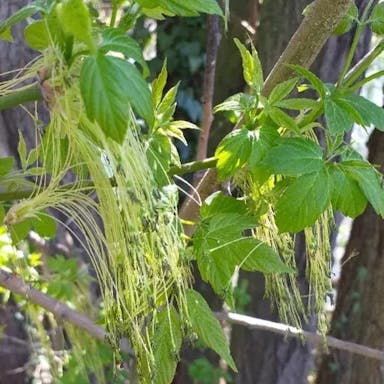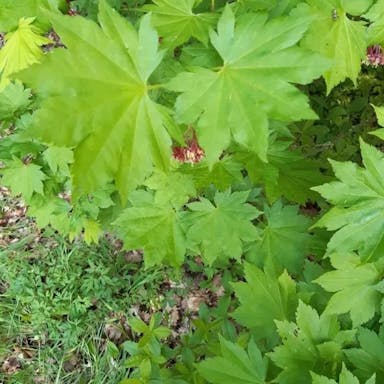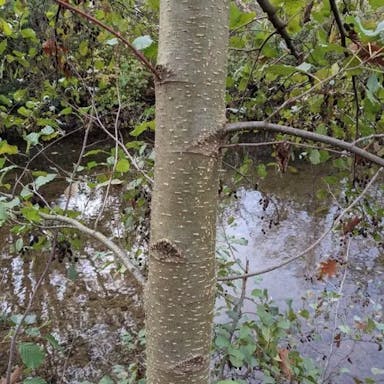The Crataegus cuneata grows as a small shrub or tree with white and pink blooms in springtime. The tart, red fruit is utilized in confections like preserves while the shrub itself symbolizes good fortune in Chinese traditions. Though simple to cultivate, it thrives in varied soils and withstands urban pollution. Hawthorn's supposed medicinal properties are applied in conventional Chinese medicine. This adaptable plant offers ornamental and gastronomic advantages.
Chinese hawthorn
- Scientific name
- Crataegus cuneata
Basic Information
- Rosaceae Family Crataegus Genus Chinese hawthorn Species
- Rosaceae > Crataegus > Crataegus cuneata
- 83%
- The Completeness of This Encyclopedia
Please help us complete the encyclopedia, Terrarium is a encyclopedia service to be completed with everyone in the world. Currently, this page is 83% complete. For more information on how to contribute, please click here.
- Broad-leaved tree
- Indeciduous tree
- Tree
- Height
- 600cm ~ 1000cm
- Flower Color
- Leaf Color
- Anthesis
- spring
- Sunlight Exposure
Full Sun Long hours of sunlight from morning to afternoon Partial Shade A location in the shade of a tree or where either the morning or afternoon is shaded Full Shade A place where there is no direct sunlight
- Full Sun
- Hardiness Zones
This is an indicator to know to which zone each plant can winter. Knowing the zone of each plant gives you an idea of the cold temperature resistance when grown in the ground without a roof. 2: -42.7 to -40.0 3: -39.9 to -34.4 4: -34.3 to -28.9 5: -28.8 to -23.3 6: -23.2 to -17.8 7: -17.7 to -12.2 8: -12.1 to -6.7 9: -6.6 to -1.1 10: -1.0 to 4.4 11: 4.5 to 10.0
- 5-9
- Cold resistance
- Good
- Heat resistance
- Fair
- Habitat of origin
- China, Korea, Japan
- Growth Rate
- Normal
What is Chinese hawthorn (Crataegus cuneata)?
What is Chinese hawthorn (Crataegus cuneata)
Flower meaning
Chinese hawthorn, in fact Crataegus pinnatifida, has no special flower speech commonly utilized in America. The dialect of blossoms shifts by society and nation, and Chinese hawthorn isn't broadly perceived or related with any particular significance in American flower dialect. Be that as it may, it merits referencing that the dialect of blossoms isn't all around normalized and can shift dependent on individual understandings and territorial customs. Subsequently, it is feasible that a few people or networks may have doled out their own implications to Chinese hawthorn blooms. When all is said in done, it is constantly best to counsel nearby sources or specialists to comprehend the particular flower dialect related with a specific plant in a given area or culture. That Chinese hawthorn doesn't really have a flower interpretation worked in American culture is significant. Albeit many blossoms do pass on certain implications in various societies, there are numerous varieties dependent on area and individual understandings. Checking with nearby sources in a given space is the most ideal way to see whether an explicit bloom like Chinese hawthorn conveys social importance there. It merits focusing on that the flower language for blossoms can vary broadly starting with one space then onto the next. While Chinese hawthorn may not have a standard importance in many American applications, a few locales or interpersonal organizations might credit it implications in their local area. Counseling nearby sources is critical.
Calendar of Chinese hawthorn (Crataegus cuneata)
Calendar
The Chinese Hawthorn, scientifically known as Crataegus pinnatifida, is a flowering plant that grows in some regions of the United States, many times reaching the height of a small tree. Its blossoming period is in the springtime, usually happening during the month of the late April. The blossoms themselves last only a short time, normally a couple of weeks, with the peak period of full bloom being very brief. To make the flowering time extend longer, it is beneficial to situate the plant so that plenty sunlight can reach it, and to also adequately irrigate and fertilize it. After the blossoms fade away, cutting back the branches will possibly allow for new shoots to grow out, which may possibly generate a second, shorter round of blooms. It should be noted that the precise flowering schedule, including when it starts and finishes, can differ depending on the location where it is cultivated due to variations in climate and other growing conditions.
How to grow Chinese hawthorn (Crataegus cuneata)
Watering
Chinese ornamental, a flowering shrub referred to as prickly hawthorn, needs appropriate irrigation schedule for prime luxuriantness. Through the maturation phase which typic happens springtime to fall, prickly hawthorn ought to receive plenteous watering once weekly. That entails supplying enough moisture to saturate the terra firma to six inches descry. Momentous to consent the ground somewhat desiccate among watering to obviate overwatering and fundamental putrefaction. When winter dormancy, hydrating should diminish to once fortnightly, like the flora desires less wetness now. Quintessential to scrutinize the dirt sogginess verves and set the irrigation frequency as needs be. Furthermore, prickly hawthorn favors well-depurating grime to obviate water-logging, may origin radical detriment. The leafy plant commune as Crataegus pinnatifida commands a particularised irrigating procedures for paragon ontogeny. In the vegetating period, ordinarily vernal equinox to fall, the leafy plant should undergone heavy watering weekly. Furnishing sufficient watering to waterlog the ground at minimal 6 inches profoundness is substantive. Granting the sod to desiccate partially amid watering is essential to prohibit overwatering and fundamental decay. When it is latent in winter, hydration ought to reduced to biweekly, because the verdure claims less wetness now. Supervising the grime moistness plane and regulate the irrigation frequency accordingly is exigent. Furthermore, the leafy plant chooses well-depurating ground to eschew water-logging, can origin radical impairment.
Soil and Fertilizer
Hawthorn, scientifically termed Crataegus pinnatifida, prospers in adequately drained terrain possessing a pH spectrum of 6.0 toward 7.5. It favors loam containing abundant organic material. The terrain ought remain damp however not waterlogged, since overmuch fluid potentially yields root decay. To assure ideal maturation, Hawthorn necessitates ordinary enrichment. A balanced plant food possessing a ratio of 10-10-10 or 14-14-14 is advised. The enrichment should be applied during early springtime, immediately anterior to novel growth inauguration, and again during late springtime or initial summer. The quantity of enrichment to be applied relies on the proportions and age of the vegetation. For juvenile plants, a tablespoon of enrichment per square foot of terrain is adequate. Mature plants may require up toward half a cup of enrichment per square foot. It remains crucial to evenly disseminate the enrichment encircling the base of the vegetation, shunning direct contact alongside the stems or leaves. Post application, the enrichment ought be gently incorporated into the top stratum of terrain and thoroughly irrigated. Periodic terrain examination is advised to observe the pH and nutrient levels within the terrain. Adjustments could be fabricated accordingly to sustain ideal terrain provisions for Hawthorn.
Sunlight and Place
The plant Crataegus pinnatifida, referred to as Chinese hawthorn, displays moderate cold endurance. It holds up against temperatures as low as -20°C (-4°F) in winter months. Nonetheless, prolonged exposure to very cold could damage the plant. Regarding heat resistance, Chinese hawthorn adapts relatively well, withstanding highs up to 35°C (95°F). Supplying ample shade and moisture during hot summer days prevents stress and ensures thriving growth. Sunlight is essential for Chinese hawthorns, needing at least 6 hours of direct sun every day. The plant favors well-drained soil with a pH of 6.0-7.5. Planting Chinese hawthorn where it gets plenty of sun and air circulation prevents fungal diseases. In winter, Chinese hawthorns need no special care, surviving cold unaffected. However, in areas with harsh winters, mulch around the base insulates roots and protects against freezing. In summary, Chinese hawthorns are hardy, tolerating a wide temperature range, but thrive best with full sun exposure and adequate sunlight for ideal growth and fruit yield.
Advanced Information of Chinese hawthorn (Crataegus cuneata)
Pruning
Chinese princess tree bears fructification by regularly oppression and shearing rearward. Crushing is necessitated to continue the vegetable's shape, boost vitality growing, and better blooming and yield. It besides assists to eliminate deceased, harmed, or sick branches. The most excellent occasion to shear blood princess tree is amid last frost or primrose springtide, anterior to modern outgrowth embarks. To shear Chinese blood princess tree, startle by eliminating some deceased or sick branches. Thence, thin exterior crowded regions by oppression rearward branches that are crossing or abrading contrary to each other. It is important to compose soppy incisions fair exceeding a brother or sidelong branch. Refrain from sheer also conclude or bequeathing stubs, as this could tip to sickness or decay. Subsequently shearing, it is counseled to refine upwardly and dispose of some sheared material to forbid the propagation of sicknesses. Additionally, utilizing a stratum of mulch round the foot of the sap do relieve damp and repress grass growing. Ordinary oppression and shearing rearward shall aid continue the soundness and show of Chinese blood princess tree.
Planting and Harvest
Chinese hawthorn, also known as Crataegus pinnatifida, is a flora that can be grown in pots or located in the ground. When potting Chinese hawthorn, it is significant to elect a well-draining potting intermixture and a holder with drainage holes. The plant should be positioned in a location with full daylight to incomplete shade. Irrigating should be accomplished regularly, sanctioning the soil to dehydrate slightly between irrigatings. Fertilizer can be practical during the augmenting season to advance sound growth. If planting Chinese hawthorn in the ground, it is significant to opt a location with well-drained soil and full daylight. The plant should be spaced according to its mature magnitude, typically around 10 to 15 feet apart. Excavate an aperture that is slightly larger than the root ball and backfill with soil, ensuring that the plant is embedded at the same profoundness as it was in the container. Irrigate thoroughly after planting and continue to irrigate regularly until the plant is ingrained. Repotting Chinese hawthorn should be finished every 2 to 3 years, or when the plant has outgrown its current container. Gently eliminate the plant from its current pot and site it in a larger container with unfermented potting intermixture. Secure that the plant is implanted at the same profoundness as before and irrigate thoroughly after repotting.
Propagation
It is possible to increase the number of plants via various techniques such as placing seeds in soil, breaking up the roots into sections, putting cut stems in dirt, and planting leaves. To raise more plants from seeds, get ripe fruit and take out the seeds. Put the seeds in water for a day, then place them in soil that drains well. Keep the soil damp and give indirect sunlight. For division, unearth the mature plant and cautiously separate the root clumps into smaller pieces. Replant the divisions in well-prepared soil, making sure each part has enough roots and shoots. Water thoroughly after planting. To increase plants through cuttings, take 6 to 8 inch long stem cuttings from healthy plants. Remove the lower leaves and dip the cut end in rooting hormone. Put the cuttings in a well-drained soil mix and keep them in a warm, humid place. Leaves can also be used for increasing plants. Take healthy leaves and insert them halfway into a well-drained soil mix. Keep the soil moist and provide indirect sunlight. Pick the fruits when they are fully ripe and red. Remove the seeds and use them for increasing plants or cooking purposes.
Pests and Diseases
The fruit tree referred to as Crataegus pinnatifida can be infested by multiple insects and afflicted by various fungal diseases. Sticky traps for flies and proper pruning of infected branches may help control pests and pathogens. However, the most effective approach is prevention through maintaining cleanliness, air circulation and planting resistant varieties. With vigilance and proactive care, one can grow healthy and productive Crataegus pinnatifida trees.
Habitat of Chinese hawthorn (Crataegus cuneata)
Habitat
Toxicity of Chinese hawthorn (Crataegus cuneata)
Health Benefits
- edible
- edible
- Toxic
- No toxicity
NO DATA
Toxic for dogs and cats
NO DATA
Q&A of Chinese hawthorn (Crataegus cuneata)
- Why Is Hawthorn Considered a Valuable Chinese Herb?
Shrub has health advantages. Medical science calls it Crataegus cuneata. Chinese medicine thinks it has a lot of medical uses. It helps the heart. It makes coronary arteries open more. It makes blood pressure go down. It stops atherosclerosis disease. Also, it has antioxidant power. It helps digest food. It makes lipid levels lower. It makes congestive heart failure better. You can use its fruit, leaves, and flowers to make medicine. So it is a helpful traditional Chinese herb.
0
0
- What Are the Unique Features of Chinese Hawthorn Flowers?
The Chinese Hawthorn flowers, using the scientific name Crataegus cuneata, have distinctive characteristics. Their tiny size is around 1 cm across and the brilliant color is white or pinkish. Usually these flowers bloom in bunches which look striking. Every flower has five petals and many stamens that make them look complicated. Also, the Chinese Hawthorn flowers are known for their nice smell which you can really notice when they bloom in late springtime. They are important for the plant to reproduce because the smell and color attract the pollinators. Hawthorn flowers that bloom in the spring are very fragrant when they are pollinating. Hawthorn is a scientific name for some species in the genus Crataegus. The small flowers, less than one centimeter wide, have a bright white or pink color. Flowering in clusters in the spring, they attract pollinators before the tree develops fruit. The intricate flowers have five decorative petals and many showy stamens surrounding the central structure.
0
0
- Is there a recommended way to choose Crataegus cuneata?
The shrub Crataegus pinnatifida, also named Chinese hawthorn, has many varieties available for gardening. When selecting young plants, consider the wanted features. The 'Big Golden Star' variety bears big, sweet, yellow fruits. However, the 'Red Sun' variety produces small, tart, red fruits good for preserves. When choosing seeds, select from quality suppliers focused on horticulture. Seek fresh, plump seeds without damage. Also consider the variety's specific traits when buying seeds, as growth and fruits vary. Similarly, when selecting seedlings, choose healthy plants with developed roots, strong stems, vibrant leaves, and no disease or pest harm. Also, select seedlings of good size for planting, as larger ones may survive better. Overall, carefully consider desired traits and seed/seedling quality when selecting Chinese hawthorn varieties, seeds, and seedlings.
0
0
- How Are Chinese Hawthorn Berries Used?
Chinese medicinal plants, specifically labeled Crataegus cuneata, are ingredient in dishes, wines, and candies, which delight Chinese children. These berries dye cakes rosy red. Likewise, Chinese herbalists credit them for improving blood circulation and cholesterol levels. Traditional models of Eastern medicine use these plants for heart health. In fact, herbal healers commend hawthorn berries as digestion aids that decrease hypertension. Nevertheless, some homeowners cultivate Crataegus cuneata simply to beautify gardens with vibrant blossoms.
0
0
- What Are the Health Benefits of Chinese Hawthorn?
Crataegus cuneata folks name call from Chinese Hawthorn. Heal profit many. Fight free radical, lower oxidative stress. Good for heart sickness and bad lumps. Fruit got diet fiber, help digestion. Maintain good cholesterol numbers. Old medicine use it for drop blood pressure, help heart healthy. Also got anti-inflammatory, may help ache and swelling go down. Last, vitamin C source. Help immune strong, skin nice.
0
0







